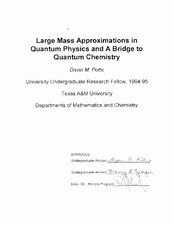| dc.description.abstract | The simplest description of propagators is this: propagators are tools for solving differential equations. Solutions to the differential equations we will be discussing are functions. If one knows a solution at a particular point, time or state, a propagator can "propagate" this particular value of the solution to other times or states. That is, from a known value of a solution function, one can reconstruct the entire solution function. This is how propagators get their name.
The fact that the entire solution can be reconstructed by the propagator proves that all the "information" contained within the solution is also contained within the propagator. Depending upon the differential equation, the propagator will contain additional and potentially useful information which is not contained in the solution. This additional information provides the driving force behind calculating propagators for the partial differential equations we will be working with.
The time-dependent Schrödinger equation,
-ħ/i d/dt Ψ(x,t)= Ĥ Ψ(x,t)
is a partial differential equation which describes some physical system, depending upon the definition of Ĥ. The wavefunction Ψ is the unknown in this equation, x and t are variables representing position and time, and the remaining terms are constants. Ψ is a function of position and time which describes the state of the physical system defined by Ĥ. By expanding Ĥ in the time-dependent Schrödinger equation, we get the standard form of the equation,
-ħ/i (∂ Ψ(x,t))/∂t= -ħ^2/2m ∇^2 Ψ(x,t) + λ V(x,t) Ψ(x,t)
≡ Ĥ Ψ(x,t)
where ∇² is the Laplacian, V(x, t) is the potential function, m is mass and λ is the coupling constant.
The propagator K(x, y’, t’, ħ, m, λ ) is defined to be the integral kernel of the Operator e^(-itĤ/ħ). Computing this integral kernel is far from being straight-forward.
Therefore, if we rewrite the last equation in the following manner,
tĤ/ħ= ħt/2m ∇^2+ λt/ħ V
≡-1/2 A ∇^2+BV
we see that there are two parameters with which to form a perturbative expansion for the propagator. One can expand the propagator in any of the following ways. See PDF for table
In the following work, we will use the large mass expansion, A→0. The different expansions each have advantages and disadvantages Formulas for computing the large mass expansion have been derived by others, but never tested. The primary purpose of this work is to examine the usefulness, the advantages and disadvantages of the large mass expansion. | en |


